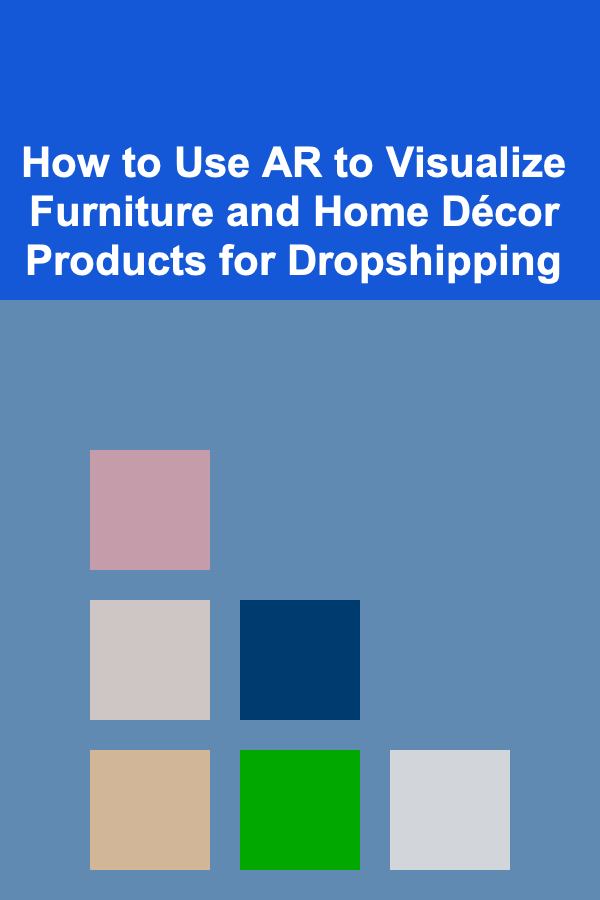
How to Use AR to Visualize Furniture and Home Décor Products for Dropshipping
ebook include PDF & Audio bundle (Micro Guide)
$12.99$6.99
Limited Time Offer! Order within the next:

Augmented Reality (AR) technology has evolved to become an essential tool for enhancing the shopping experience. In particular, for the dropshipping industry, AR offers a unique way to showcase furniture and home décor products to customers before they make a purchase. This technology allows shoppers to visualize how products will look in their own homes, helping them make better purchasing decisions while boosting conversion rates and reducing returns.
In this guide, we'll explore how to effectively use AR for visualizing furniture and home décor products in dropshipping, along with actionable steps to implement AR in your business.
Understanding the Power of AR for Dropshipping
Before diving into how to use AR for your dropshipping business, it's important to understand its potential. AR blends digital elements with the physical world, allowing users to interact with 3D models of products in real-time through their smartphones or other devices. In the context of furniture and home décor, AR can create an interactive shopping experience where customers can:
- See how a product will fit and look in their living space
- Assess the color, texture, and size of furniture and décor items
- Visualize the product in different lighting conditions
- Experiment with multiple items in a single room to create the perfect aesthetic
By using AR, you can bridge the gap between online shopping and in-store experiences, offering a way for customers to make more informed decisions.
Why AR Is Crucial for Furniture and Home Décor Dropshipping
Enhanced Customer Engagement
AR technology significantly improves the level of engagement between customers and your products. Instead of just browsing static images of furniture, customers can interact with realistic 3D models, rotate them, and place them in different locations in their homes.
Increased Confidence in Purchases
One of the biggest barriers in the furniture and home décor industry is uncertainty about how a product will fit into a customer's existing home environment. With AR, customers can virtually "try before they buy," which increases their confidence in making a purchase.
Reduction in Returns
A common issue with online furniture shopping is product returns due to incorrect sizing or mismatched aesthetics. AR allows customers to visualize products accurately, which reduces the likelihood of returns stemming from dissatisfaction.
Higher Conversion Rates
By offering an immersive shopping experience, AR can reduce friction in the decision-making process. When customers can virtually place furniture in their homes and see how it complements their existing décor, they are more likely to complete a purchase, leading to higher conversion rates.
Implementing AR for Dropshipping Furniture and Home Décor
Now that we understand the advantages of using AR, let's explore how to integrate this technology into your dropshipping business effectively.
Step 1: Choose the Right AR Solution for Your Store
There are several AR tools and platforms available that can help you integrate AR features into your dropshipping business. Here are some key options:
- AR SDKs (Software Development Kits): These kits, such as ARKit (for iOS) and ARCore (for Android), allow developers to build custom AR experiences. If you have technical expertise or a development team, this is a great option for creating a unique AR experience tailored to your business.
- AR Plugins for E-Commerce Platforms: If you use platforms like Shopify or WooCommerce, there are AR plugins available that can easily integrate with your existing online store. Tools like Shopify's AR Quick View and Augment offer ready-made solutions for adding AR functionality to your product pages without the need for extensive coding knowledge.
- Third-Party AR Apps: Some third-party apps like Ikea Place and Houzz allow users to visualize furniture in their homes using AR technology. You can partner with such platforms to expand your product visibility, although the integration process may be more limited compared to a custom-built solution.
Step 2: Create High-Quality 3D Models of Your Products
To provide an effective AR experience, you need high-quality 3D models of the furniture and décor products you sell. Here's how to approach this:
- Hire 3D Designers or Use 3D Modeling Software: If you don't have 3D models for your products, you'll need to either hire a 3D designer or use software tools like Blender , SketchUp , or Autodesk Maya to create them. The models should be highly detailed and accurately represent the product's size, texture, and proportions.
- Photogrammetry: This technique involves taking multiple high-resolution photos of a product from different angles and then using specialized software to generate 3D models. It's an effective method if you want to create realistic models of your physical products.
- Ensure File Compatibility: When creating 3D models, make sure they are compatible with AR software. Common file formats like GLTF , USDZ , or OBJ are widely supported across different platforms.
Step 3: Optimize the AR Experience for User Devices
AR can work seamlessly on smartphones and tablets, but the experience will vary depending on the device's specifications. Here are some considerations to ensure a smooth experience:
- Device Compatibility: Most modern smartphones support AR, but make sure that the AR experience is optimized for both iOS and Android devices. Check that your models load quickly, rotate smoothly, and scale appropriately.
- Loading Speed and Performance: AR experiences that are slow or laggy can frustrate customers. Optimize the 3D models to reduce file sizes and improve loading speeds without compromising visual quality.
- Lighting and Shadow Effects: Lighting is crucial in AR visualization to create realistic renderings. Ensure that your AR tool supports dynamic lighting adjustments based on the user's environment for a more accurate representation of how the product will look in different settings.
Step 4: Integrate AR into Your Product Pages
Once you have high-quality 3D models and the right AR tool in place, it's time to integrate AR into your online store. Here's how to do it:
- Add AR Buttons: Place a prominent AR button on your product pages so customers know they can view the product in AR. Make sure it's easily accessible and intuitive to use.
- Incorporate Interactive Features: Allow customers to rotate the products, zoom in and out, and move them around their virtual space. Offering a fully interactive AR experience makes it more engaging.
- Promote the AR Feature: Many customers might not know that they can use AR to visualize products. Use pop-ups, banners, or videos to educate customers about the feature and how it can enhance their shopping experience.
Step 5: Collect Customer Feedback and Optimize
After integrating AR into your store, it's essential to gather customer feedback and continuously improve the experience. Here's how to ensure the AR tool is effective:
- Monitor Analytics: Track how often customers use the AR feature and whether it leads to conversions. Analytics can reveal which products are most frequently visualized and if there are any issues with usability.
- Customer Surveys: Ask your customers for feedback on their AR experience. Are they able to visualize the product clearly? Was the app easy to use? Use this feedback to make improvements.
- Iterate and Improve: The AR experience should evolve over time. As new products are added to your store or new technology becomes available, keep updating your AR functionality to maintain a cutting-edge experience.
Additional Tips for Success in AR-Based Dropshipping
- Start with a Small Selection of Products: Initially, offer AR visualization for a limited number of high-demand products, such as bestsellers or flagship items. This will allow you to test the system and optimize it before expanding to your entire catalog.
- Educate Your Customers: Ensure your customers understand how AR can enhance their shopping experience. Consider creating a tutorial or walkthrough for first-time users.
- Stay Current with AR Trends: AR is constantly evolving. Keep an eye on new developments in AR technology, such as the integration of AI for even more accurate product placements, to stay ahead of the competition.
Conclusion
AR technology offers a powerful way to enhance the online shopping experience, particularly for dropshipping businesses selling furniture and home décor products. By allowing customers to visualize products in their own homes, you can significantly improve their confidence in their purchases, reduce return rates, and boost conversions. With the right tools, high-quality 3D models, and effective integration, AR can become a game-changing feature for your business. As AR technology continues to improve, its potential to revolutionize the dropshipping industry will only grow, making it a must-have tool for businesses looking to stay competitive in the digital age.

How to Make a Checklist for Home Safety Inspections
Read More
How to Make Money Online as a Packaging Designer: 10 Actionable Ideas
Read More
How to Plan a DIY Spa Day at Home for Relaxation
Read More
How to Soundproof Your Apartment Walls Without Construction
Read More
How to Use Hooks and Racks for Entryway Organization
Read More
The Art of Operations Leadership: Leading Teams and Driving Efficiency
Read MoreOther Products

How to Make a Checklist for Home Safety Inspections
Read More
How to Make Money Online as a Packaging Designer: 10 Actionable Ideas
Read More
How to Plan a DIY Spa Day at Home for Relaxation
Read More
How to Soundproof Your Apartment Walls Without Construction
Read More
How to Use Hooks and Racks for Entryway Organization
Read More